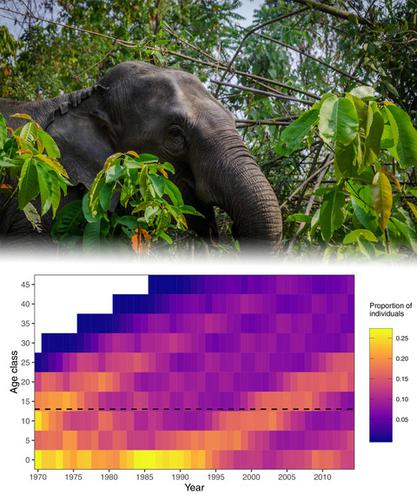当前位置:
X-MOL 学术
›
J. Anim. Ecol.
›
论文详情
Our official English website, www.x-mol.net, welcomes your feedback! (Note: you will need to create a separate account there.)
Changes in age‐structure over four decades were a key determinant of population growth rate in a long‐lived mammal
Journal of Animal Ecology ( IF 3.5 ) Pub Date : 2020-07-17 , DOI: 10.1111/1365-2656.13290 John Jackson 1, 2 , Khyne U Mar 3 , Win Htut 4 , Dylan Z Childs 2 , Virpi Lummaa 3
Journal of Animal Ecology ( IF 3.5 ) Pub Date : 2020-07-17 , DOI: 10.1111/1365-2656.13290 John Jackson 1, 2 , Khyne U Mar 3 , Win Htut 4 , Dylan Z Childs 2 , Virpi Lummaa 3
Affiliation

|
1. A changing environment directly influences birth and mortality rates, and thus population growth rates. However, population growth rates in the short-term are also influenced by population age-structure. Despite its importance, the contribution of age-structure to population growth rates has rarely been explored empirically in wildlife populations with long-term demographic data. 2. Here, we assessed how changes in age-structure influenced short-term population dynamics in a semi-captive population of Asian elephants (Elephas maximus). 3. We addressed this question using a demographic dataset of female Asian elephants from timber camps in Myanmar spanning 45 years (1970-2014). First, we explored temporal variation in age-structure. Then, using annual matrix population models, we used a retrospective approach to assess the contributions of age-structure and vital rates to short-term population growth rates with respect to the average environment. 4. Age-structure was highly variable over the study period, with large proportions of juveniles in the years 1970 and 1985, and made a substantial contribution to annual population growth rate deviations. High adult birth rates between 1970-1980 would have resulted in large positive population growth rates, but these were prevented by a low proportion of reproductive-aged females. 5. We highlight that an understanding of both age-specific vital rates and age-structure is needed to assess short-term population dynamics. Furthermore, this example from a human-managed system suggests that the importance of age-structure may be accentuated in populations experiencing human disturbance where age-structure is unstable, such as those in captivity or for endangered species. Ultimately, changes to the environment drive population dynamics by influencing birth and mortality rates, but understanding demographic structure is crucial for assessing population growth.
中文翻译:

四十多年来年龄结构的变化是长寿哺乳动物种群增长率的关键决定因素
1. 不断变化的环境直接影响出生率和死亡率,进而影响人口增长率。然而,短期内的人口增长率也受人口年龄结构的影响。尽管它很重要,但在具有长期人口统计数据的野生动物种群中,很少有经验地探索年龄结构对人口增长率的贡献。2. 在这里,我们评估了年龄结构的变化如何影响半圈养亚洲象(Elephas maximus)的短期种群动态。3. 我们使用来自缅甸木材营地 45 年(1970-2014 年)的雌性亚洲象的人口统计数据集来解决这个问题。首先,我们探索了年龄结构的时间变化。然后,使用年度矩阵人口模型,我们使用回顾性方法来评估年龄结构和生命率对相对于平均环境的短期人口增长率的贡献。4. 研究期间的年龄结构变化很大,1970 年和 1985 年的青少年比例很大,对年人口增长率的偏差做出了重大贡献。1970 年至 1980 年间的高成人出生率会导致大量的正人口增长率,但由于育龄女性比例低而无法实现。5. 我们强调,评估短期人口动态需要了解特定年龄的生命率和年龄结构。此外,这个来自人类管理系统的例子表明,年龄结构的重要性可能会在经历人类干扰的人群中得到强调,其中年龄结构不稳定,例如圈养或濒临灭绝的物种。最终,环境变化通过影响出生率和死亡率来推动人口动态,但了解人口结构对于评估人口增长至关重要。
更新日期:2020-07-17
中文翻译:

四十多年来年龄结构的变化是长寿哺乳动物种群增长率的关键决定因素
1. 不断变化的环境直接影响出生率和死亡率,进而影响人口增长率。然而,短期内的人口增长率也受人口年龄结构的影响。尽管它很重要,但在具有长期人口统计数据的野生动物种群中,很少有经验地探索年龄结构对人口增长率的贡献。2. 在这里,我们评估了年龄结构的变化如何影响半圈养亚洲象(Elephas maximus)的短期种群动态。3. 我们使用来自缅甸木材营地 45 年(1970-2014 年)的雌性亚洲象的人口统计数据集来解决这个问题。首先,我们探索了年龄结构的时间变化。然后,使用年度矩阵人口模型,我们使用回顾性方法来评估年龄结构和生命率对相对于平均环境的短期人口增长率的贡献。4. 研究期间的年龄结构变化很大,1970 年和 1985 年的青少年比例很大,对年人口增长率的偏差做出了重大贡献。1970 年至 1980 年间的高成人出生率会导致大量的正人口增长率,但由于育龄女性比例低而无法实现。5. 我们强调,评估短期人口动态需要了解特定年龄的生命率和年龄结构。此外,这个来自人类管理系统的例子表明,年龄结构的重要性可能会在经历人类干扰的人群中得到强调,其中年龄结构不稳定,例如圈养或濒临灭绝的物种。最终,环境变化通过影响出生率和死亡率来推动人口动态,但了解人口结构对于评估人口增长至关重要。












































 京公网安备 11010802027423号
京公网安备 11010802027423号